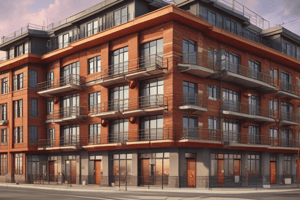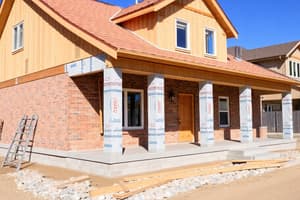Podcast
Questions and Answers
What was the primary reason for amending H1D6 and H1D8 in the Building Code of Australia?
What was the primary reason for amending H1D6 and H1D8 in the Building Code of Australia?
- To improve readability and structure (correct)
- To decrease the cost of building materials
- To increase the number of building inspections
- To reduce the number of building provisions
What was amended in Part H2 of the Building Code of Australia?
What was amended in Part H2 of the Building Code of Australia?
- Only weatherproofing requirements
- Neither damp nor weatherproofing requirements
- Both damp and weatherproofing requirements (correct)
- Only damp-proofing requirements
What was replaced with 'annual exceed probability' in the Building Code of Australia?
What was replaced with 'annual exceed probability' in the Building Code of Australia?
- Annual rainfall measurement
- Building inspection frequency
- Average recurrence interval (correct)
- Weather forecasting methods
What was added to H2D4 in the Building Code of Australia?
What was added to H2D4 in the Building Code of Australia?
What was the focus of the amendment to H1D11 in the Building Code of Australia?
What was the focus of the amendment to H1D11 in the Building Code of Australia?
What is the primary purpose of the amendment to H2O1 in the Building Code of Australia?
What is the primary purpose of the amendment to H2O1 in the Building Code of Australia?
What was the reason for amending H2P1 in the Building Code of Australia?
What was the reason for amending H2P1 in the Building Code of Australia?
What is the main benefit of the amendment to H1D6 and H1D8 in the Building Code of Australia?
What is the main benefit of the amendment to H1D6 and H1D8 in the Building Code of Australia?
What was the focus of the amendment to Part H2 of the Building Code of Australia?
What was the focus of the amendment to Part H2 of the Building Code of Australia?
What is the purpose of the Deemed-to-Satisfy pathway added to H2D4 in the Building Code of Australia?
What is the purpose of the Deemed-to-Satisfy pathway added to H2D4 in the Building Code of Australia?
Flashcards are hidden until you start studying
Study Notes
Building Code of Australia (BCA) Provisions
- Volumes: The BCA consists of three volumes: Volume One, Volume Two, and Volume Three, each covering different aspects of building regulations.
Provisions
- Class 2 and 3 buildings: These buildings must not exceed 25m in effective height.
- Fire control centres: No specific provisions mentioned.
- Smoke detection and alarm systems: Must comply with various clauses, including E2D3, E2D5, and E2D7.
- Smoke exhaust systems: Must comply with clauses C3D13, E2D10, and E2D14.
- Smoke-and-heat vents: Must comply with clauses E2D10, E2D14, and E2D15.
- Residential fire safety systems: Must comply with clauses S18C3 and S18C4.
- Lift installations: Must comply with clause E3D2.
- Photoluminescent exit signs: Must comply with clause E4D8.
- Waterproofing and water resistance: Must comply with clause F1D6.
Accessible Design
- Accessible adult change facilities: Must comply with clauses F4D12 and S15C1.
Structural Requirements
- Fire-resisting construction: Must comply with various clauses, including C2D2, C2D10, and C3D6.
- Structural tests for lightweight construction: Must comply with clauses B1D4, C2D9, and S32C2.
Fire Safety
- Fire hazard properties: Must comply with clause A5G6.
- Fire-resistant materials: Must comply with clause A5G5.
- Fire-protected timber: Must comply with clause S1C2.
Other Provisions
- Bushfire protection: Certain Class 9 buildings must comply with clause G5D4.
- House energy rating software: Must comply with clause H6D2.
- Modelling parameters: Must comply with clause J1V3.
History of Adoption
- NCC Volume Two: Each edition has a specific adoption date, as outlined in Table 1.
Studying That Suits You
Use AI to generate personalized quizzes and flashcards to suit your learning preferences.




